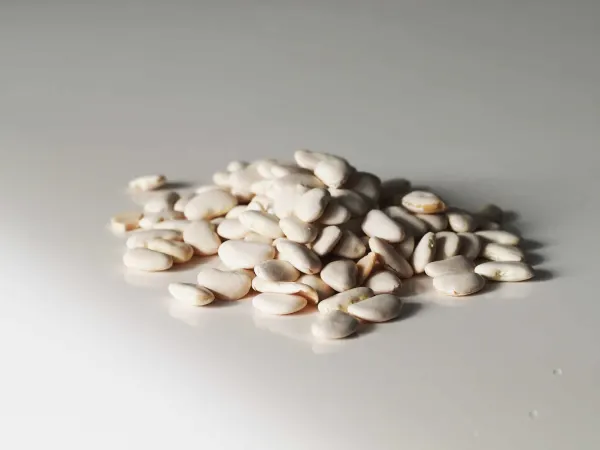Lima Bean
Legume
Age Suggestion
6 months
Iron-Rich
Yes
Common Allergen
No

When can babies have lima beans?
Lima beans may be introduced as soon as baby is ready to start solids, which is generally around 6 months of age. Make sure that the lima beans are fully cooked, as they can cause illness when undercooked or raw.
Lima beans originated in the Americas, where Central and South American people learned to cultivate the legume more than 8,000 years ago. In the 16th century, European colonizers took beans to other parts of the world, naming the legume after the South American city of Lima. Centuries of global trade and agricultural development led to many other names for lima beans: Burma beans, Christmas beans, garrofón, pallar, and sieva beans, to name a few.
Are lima beans healthy for babies?
Yes, as long as they are fully-cooked, as lima beans can cause illness when undercooked or raw. Nutritionally, lima beans are a terrific source of plant-based protein and fiber for a healthy heart and stable blood sugars. They also contain lots of vitamins and minerals, including folate and most B vitamins, as well as choline, which helps support brain health. Lastly, lima beans are rich in iron and zinc, two essential nutrients that babies often don’t get enough of in their diets. When served with foods that contain lots of vitamin C (like berries, broccoli, cauliflower, citrus, and bell pepper), the body absorbs more of the iron in the beans.
Are lima beans a common allergen?
No. Lima beans are not a common food allergen, though allergic reactions to lima beans have been reported. Those who are already allergic to soybeans or other legumes may be at higher risk for a lima bean allergy, but this seems to be a rare occurrence. Individuals who are allergic to mesquite tree pollen may experience Oral Allergy Syndrome (also known as pollen-food allergy syndrome) when consuming lima beans. Oral Allergy Syndrome typically results in short-lived itching, tingling, or burning in the mouth and is unlikely to result in a dangerous reaction.
As you would do when introducing any new food, offer a small amount for the first few servings. If there is no adverse reaction, gradually increase the amount served over future meals.
Are lima beans a choking hazard for babies?
Yes. Lima beans are small, rounded, and can be firm, especially when raw or undercooked, qualities that can increase the risk of choking. To reduce the risk, prepare and serve lima beans in an age-appropriate way. As always, make sure you create a safe eating environment and stay within an arm’s reach of baby during meals. For more information on choking, visit our sections on gagging and choking and familiarize yourself with the list of common choking hazards.
Videos
Are lima beans and butter beans the same thing?
Yes. Lima bean and butter bean are the same legume with variations in color, shape, and taste. Some are small and pale green, others are larger and pale yellow, and heirloom varieties can have speckles and streaks of magenta, scarlet, and other bright colors. All have a creamy, starchy texture and nutty taste with nuances in taste from one type to another.
How do you serve lima beans to babies?
Every baby develops on their own timeline, and the suggestions on how to cut or prepare particular foods are generalizations for a broad audience.
6 months old +:
Crush or blend cooked lima beans into a textured mash or smooth paste for baby to scoop with their hands. If you prefer, serve the mash or paste with a spoon or thinly spread it on toast strips or other age-appropriate food. To boost nutrition, stir in breast milk, formula, olive oil, or even yogurt when making the mash or paste. You can also stir the crushed or pureed lima beans into soft, scoopable foods like corn grits, mashed vegetables, rice porridge, or stewed greens. Just start with small portions of lima beans at first, to minimize any digestive discomfort from the high-fiber food.
9 months old +:
Babies with a developing pincer grasp (where the thumb meets the pointer finger) may graduate to cooked lima beans that have been gently flattened between your thumb and finger before serving. Alternatively, continue serving mashed or pureed lima beans for baby to scoop with hands, dip in fingers or pieces of cooked vegetables, or practice eating with a spoon.
12 months old +:
By this age, toddlers are typically able to handle whole lima beans that are fully cooked until soft. To encourage self-feeding with utensils, spear a lima bean with an age-appropriate fork and lay the utensil next to the food for the child to try to pick up. If help is needed, pass the utensil in the air for the child to grab from you. If serving a whole bean makes you nervous, continue to mash or flatten the beans.
Written by
Expert Tips Delivered to Your Inbox
Sign up for weekly tips, recipes and more!
The content offered on SolidStarts.com is for informational purposes only. Solidstarts is not engaged in rendering professional advice, whether medical or otherwise, to individual users or their children or families. No content on this site, regardless of date, should ever be used as a substitute for direct medical advice from your doctor or your medical or health professional, nutritionist, or expert in pediatric feeding and eating. By accessing the content on SolidStarts.com, you acknowledge and agree that you are accepting the responsibility for your child’s health and well-being. In return for providing you with an array of content “baby-led weaning” information, you waive any claims that you or your child may have as a result of utilizing the content on SolidStarts.com.







